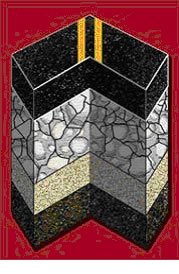Perpetual Pavement
Combining the well-documented smoothness and safety advantages of asphalt with an advanced, multi-layer pavement design process...
Perpetual Pavement combines the well-documented smoothness and safety advantages of asphalt with an advanced, multi-layer pavement design process, that with routine maintenance, extends the useful life of a roadway to half a century or more. Pavements designed and constructed in accordance with the Perpetual Pavement concept will last, and last, and last.
How it Works
Perpetual Pavements use multiple layers of durable asphalt to produce a safe, smooth, long-lasting road. The Hot Mix Asphalt (HMA) design begins with a strong, yet flexible bottom layer that resists tensile strain caused by traffic, and thus stops cracks from forming in the bottom of the pavement. A strong intermediate layer completes the permanent structural portion, and a final layer of rut-resistant HMA yields a surface that lasts many years before scheduled restoration.
A Perpetual Pavement provides a durable, safe, smooth, long-lasting roadway without expensive, time-consuming and traffic-disrupting reconstruction or major repair.

Roads that don't wear out
One of the keys to sustainability is long life. With Perpetual Pavements, asphalt pavements have an extremely long lifespan.1
A Perpetual Pavement is constructed so that distress occurs in the top layer only. The only rehabilitation required is removal of the surface and resurfacing with an asphalt overlay. Using current pavement technologies, this can be done on an infrequent basis—every 15 to 20 years. The reclaimed material is then recycled. Perpetual Pavement is the ultimate in sustainable design and construction.
While the Perpetual Pavement name is relatively new, the concept is not. In fact, more than 35 pavements have received the Perpetual Pavement Award since 2001. These award-winning roads, streets, highways, and airport runways have been in place for at least 35 years, with a minimum of maintenance and no full-depth reconstruction.
Rubblization
When concrete pavements reach the end of their useful life, they must undergo expensive, time-consuming rehabilitation or be completely removed and replaced. This process squanders precious natural resources, in addition to inconveniencing the traveling public. Prolonged road closures also lead to congestion, which consumes energy and produces excess emissions. Asphalt's answer is a sustainable process called rubblization, in which the concrete pavement is left in place, "rubblized" (fractured), and used as the base for a new Perpetual Pavement.
In addition to the environmental advantages, cost savings can be significant. The rubblization process is much faster than the remove-and-replace option. It can also be accomplished through temporary lane closures, without the necessity for traffic to be detoured onto parallel routes.
Public safety
Smooth asphalt roads give vehicle tires superior contact with the road.
One type of asphalt surface, known as open-graded friction course, allows rainwater to drain through the surface layer and off to the sides, reducing the amount of splash and spray kicked up by vehicles.
Noise reduction
Asphalt is the quiet pavement. Quiet pavement technologies include open-graded surfaces, fine-graded surfaces, and two-layer open-graded pavements.2 Studies show that the noise-reducing properties of asphalt last for many years.3
Noise reductions of
For more information on quiet pavement technology, visit www.quietpavement.com.
Congestion reduction
Asphalt pavements are faster to construct and rehabilitate. In crowded urban areas, where closing a road for rehabilitation or reconstruction would dump increased traffic on neighboring routes—adding to congestion-asphalt is the answer. Highways and roads can be milled for recycling, then overlaid, during off-peak hours, so that most motorists are never inconvenienced.
Smoothness and conservation
Studies at a pavement test track in
When trucks are driven on rough surfaces, the tires bounce and deliver heavy, punishing impacts to the pavement. Some experts estimate that a 25 percent increase in smoothness can result in a 9 to 10 percent increase in the life of pavements.
Building smooth asphalt roads is simple and cost-effective. Keeping them that way is fast, easy and inexpensive.
Taking the punishment
Any doubts about whether asphalt is durable can be answered at racetracks and airports. These pavements are punished by heavy loads, but asphalt stands up to them.
When vehicles reach speeds of 200 mph and more, and a car's undercarriage clears the pavement by about one inch, the pavement had better be smooth. That's why nearly all racetracks—for both Formula One and NASCAR racing—use asphalt.
REFERENCES
1. Perpetual Bituminous Pavements. Transportation Research Circular Number 503. Transportation Research Board,
2. Newcomb, Dave, and Larry Scofield, "Quiet Pavements Raise the Roof in Europe," Hot Mix Asphalt Technology, National Asphalt Pavement Association, Lanham, MD, September/October 2004.
3. Reyff, James, et al., I-80
4. Sime, M., et al. WesTrack Track Roughness, Fuel Consumption, and Maintenance Costs. Tech Brief published by Federal Highway Administration,
